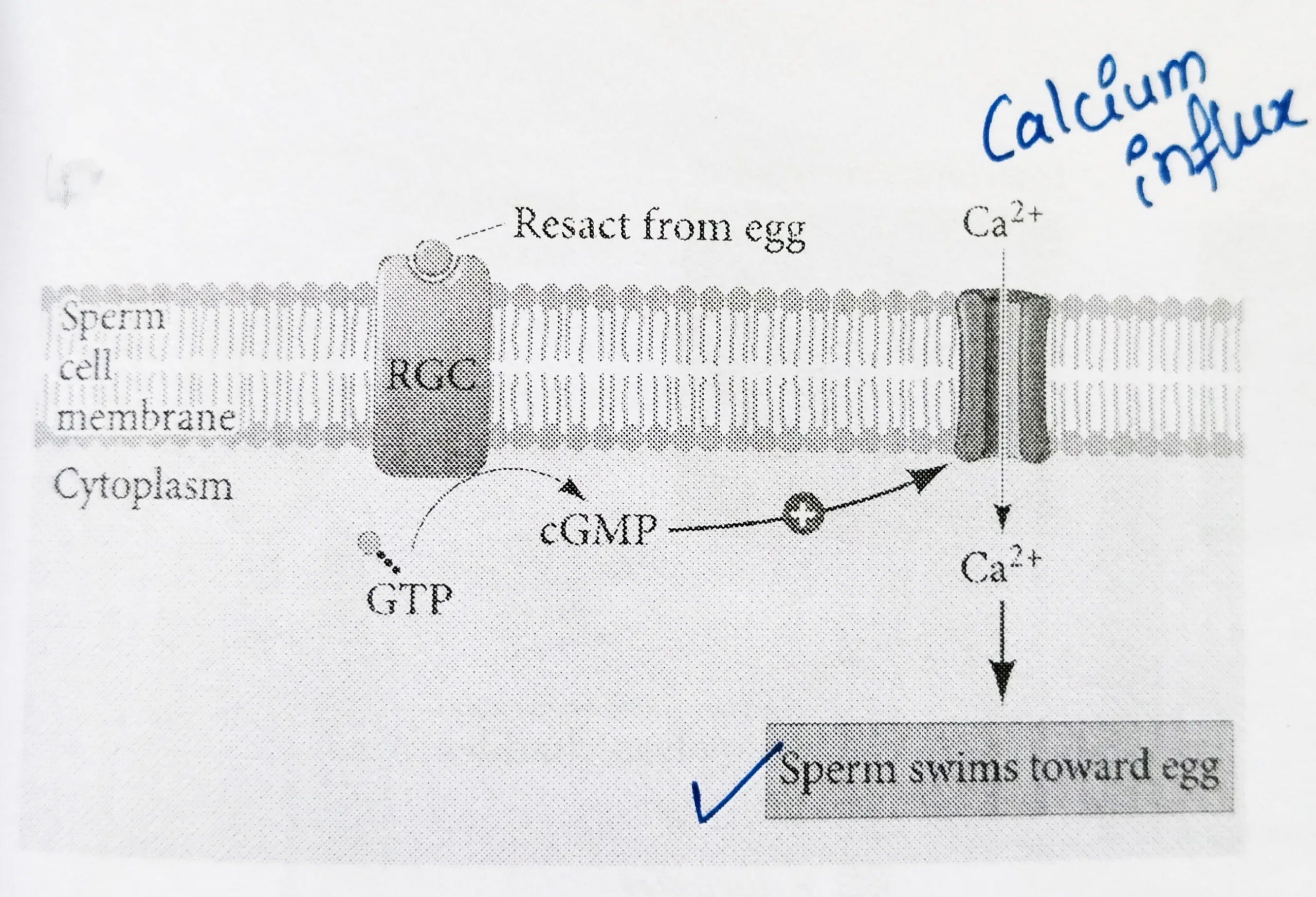Table of Contents
Sea urchin fertilization is one of the most important topics for any Life science-related competitive exam. The organisms that involve external fertilization face some problems. To solve problems there are two major mechanisms: species-specific sperm attraction and species-specific sperm activation.
Sea Urchin fertilization: Major mechanism: sperm attraction:
- In many species, sperm are attracted to egg of their species by chemotaxis- by following a gradient of a chemical secreted by the egg.
- In the sea urchin fertilization process, sperm motility is acquired only after the sperm are spawned. As long as the sperm cells are in the testes, they cannot move because their internal pH is kept low (pH 7.2) by the high concentrations of CO2 in the gonad.
- However, one sperm are spawned into sea water, their pH is elevated to about 7.6, leading to the activation of the dynein ATPase. The splitting of ATP provides the energy for the flagella to wave, and the sperm stars to swim faster.
- But the ability to move does not provide the sperm with a direction. In echinoderms, direction is provided by small chemotactic peptides called sperm- activating peptides (SAPs). One such SAP is resact, a 14- amino acid peptide that has been isolated from the egg jelly of the sea urchin Arbacia punctulata.
- Resact diffuses readily from the egg jelly into sea water and has a profound effect at very low concentrations when added to a suspension of Arbacia sperm.
- Experimental aspect: When. Drop of sea water containing Arbacia sperm is placed on a microscope slide, the sperm generally swim in circles about 50 micrometer in diameter. Within seconds after a small amount of resact is injected, sperm migrate into the region of the injection and congregate there. As resact diffuses from the area of injection, more sperm are recruited into the growing cluster.
- Resact is specific for A. punctulata and does not attract sperm of other urchin species. An analogue compound, speract has been isolated from the purple sea urchin, Strongylocentrotus purpuratus.
- A. punctulata sperm have receptors in their cell membranes that bind resact. When the extra cellular side of the receptor binds resact, it activates latent guanylyl cyclase in the cytoplasmic side of the receptor.
- Active guanylyl cyclase causes the sperm cell to produce more cyclic GMP (cGMP). This compound activates a calcium channel in the cell membrane of the sperm tail, allowing the influx of calcium ions (Ca2+) from seawater into the tail.
- The sperm-specific calcium channels are encoded by CatSper genes – the same genes that control the direction of sperm migration in mice and humans.
- The increase in cGMP and calcium ions activate both the mitochondrial ATP- generating apparatus and the dynein ATPase that stimulates flagellar movement in sperm.
- In addition, the sperm sense the SAP gradient by curving their tails, interspersing straight swimming with a turn to sense the environment.
- The binding of a single resact molecule may be enough to provide the direction for the sperm, which swim up a concentration gradient of this compound until they reach the egg.
- Thus, resact functions as a sperm-attracting peptide as well as a sperm- activating peptide.
Diagram, related to the above explanation [Sea Urchin fertilization: Major mechanism: sperm attraction]:
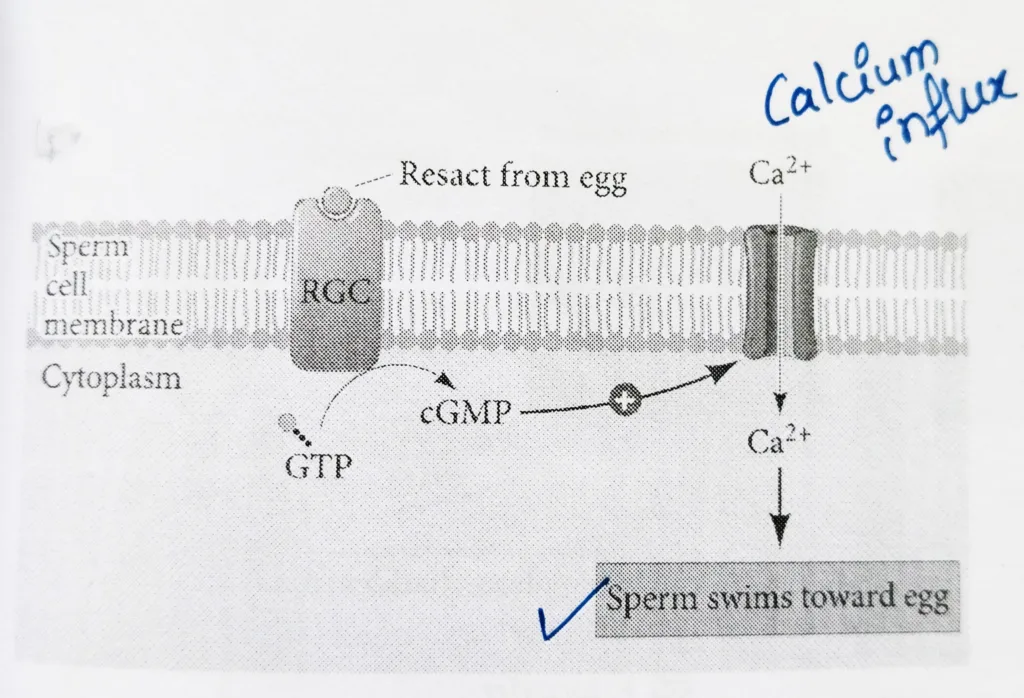
Sea Urchin fertilization: The acrosome reaction:
- The acrosome reaction in the sea urchin fertilization process is initiated by the contact of sperm with the egg jelly. Contact causes the exocytosis of the sperm’s acrosomal vesicle. The proteolytic enzymes and proteosomes thus released digest a path through the jelly coat to the egg cell surface.
- In sea urchin, the acrosome reaction is initiated by sulfate-containing polysaccharides in the egg jelly that bind to specific receptors located directly above the acrosomal vesicle on the sperm cell membrane.
- In Strongylocentrotus purpuratus, the acrosome reaction is initiated by a repeating polymer of fucose sulfate. When this sulfated polysaccharide binds to its receptor on the sperm, the receptor three sperm membrane proteins – a) a calcium channel that allows calcium ions (Ca2+) to enter the sperm head. b) a sodium hydrogen exchanger that pumps sodium ions (Na+) into the sperm as it pumps out hydrogen ions (H+). c) a phospholipase enzyme that makes another second messenger, the phospholipid inositol 1,4,5- triphosphate ( IP3).
- IP3 can release calcium ions (Ca2+) from inside the sperm, probably from within the acrosome. The elevated calcium ions (Ca2+) level triggers the fusion of the acrosomal membrane with the adjacent sperm cell membrane, releasing enzymes that can lyse a path through the egg jelly to the vitelline envelope.
- The second part of the acrosome reaction involves the extension of the acrosomal process by the polymerization of globular actin molecules into actin filaments. The influx of calcium ions (Ca2+) is thought to activate the protein RhoB in the acrosomal region and midpiece of the sperm.
- This GTP-binding protein helps to organize the actin cytoskeleton in many types of cells and is thought to be active in polymerizing actin to make the acrosomal process.
Diagram of Acrosome reaction:
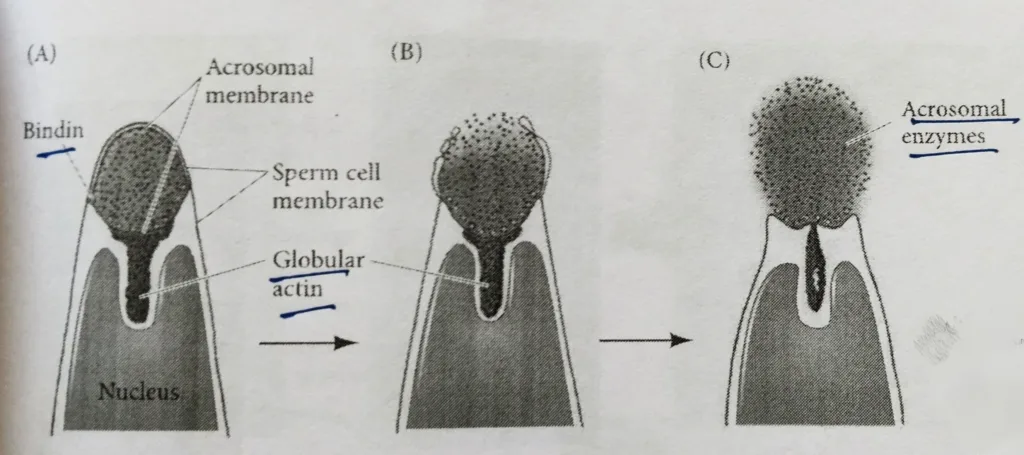
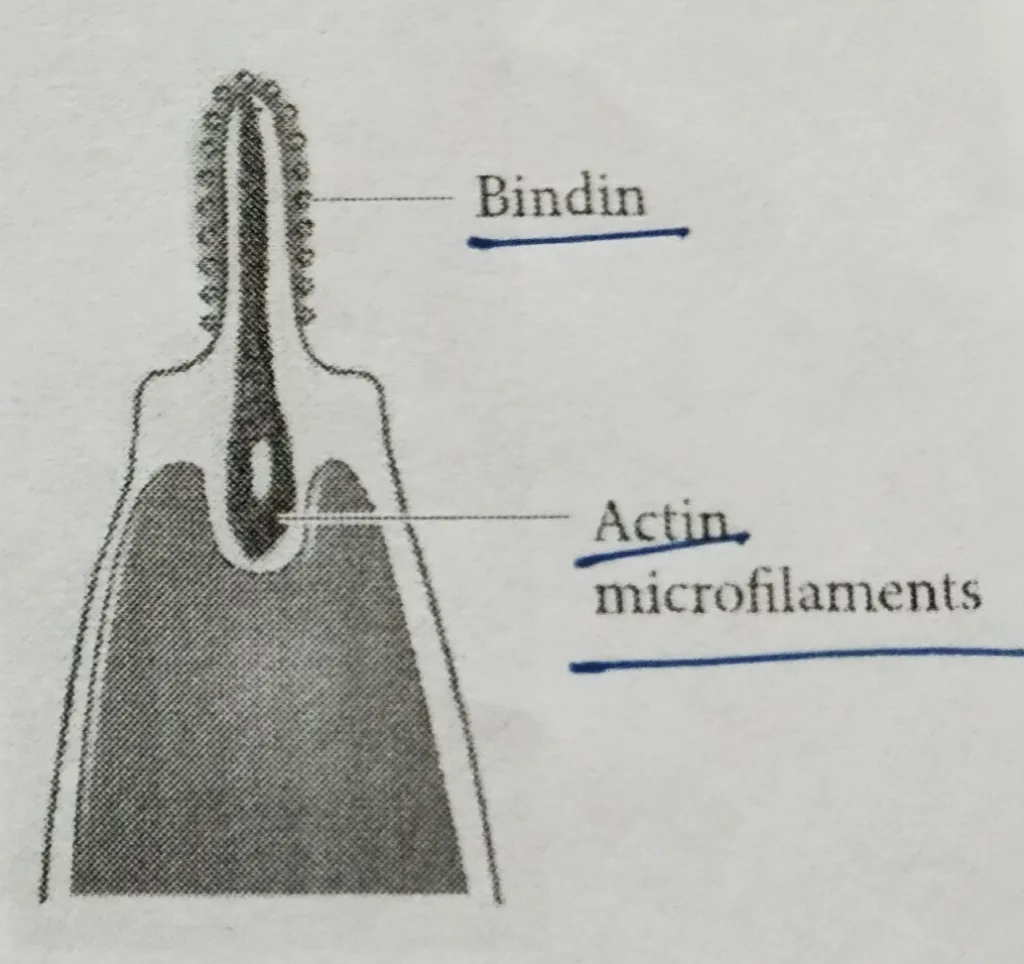
Sea Urchin fertilization: Recognition of the egg’s extracellular coat:
- The acrosomal reaction mediating the recognition in sea urchin is an insoluble, 30,500-Da protein called bindin.
- Sperm bindin, like egg jelly polysaccharides, is usually species – specific.
- Bindin isolated from the acrosome of Strongylocentrotus purpuratus and found it to be capable of binding to dejellied eggs of the same species.
- However, Bindin isolated from the acrosome of Strongylocentrotus purpuratus does not bind to the dejellied eggs of Strongylocentrotus franciscanus.
- The receptor for sperm bindin on the egg vitelline envelope appears to recognize the protein portion of bindin on the acrosome in a species-specific manner.
- Closely related species of sea urchins have divergent bindin receptors, and eggs will adhere only to bindin of their own species.
- Thus, species-specific recognition of sea urchin gametes can occur at the levels of sperm attraction, sperm activation, the acrosome reaction, and sperm adhesion to the egg surface.
Diagram, related to the above explanation [Sea Urchin fertilization: Recognition of the egg’s extracellular coat]
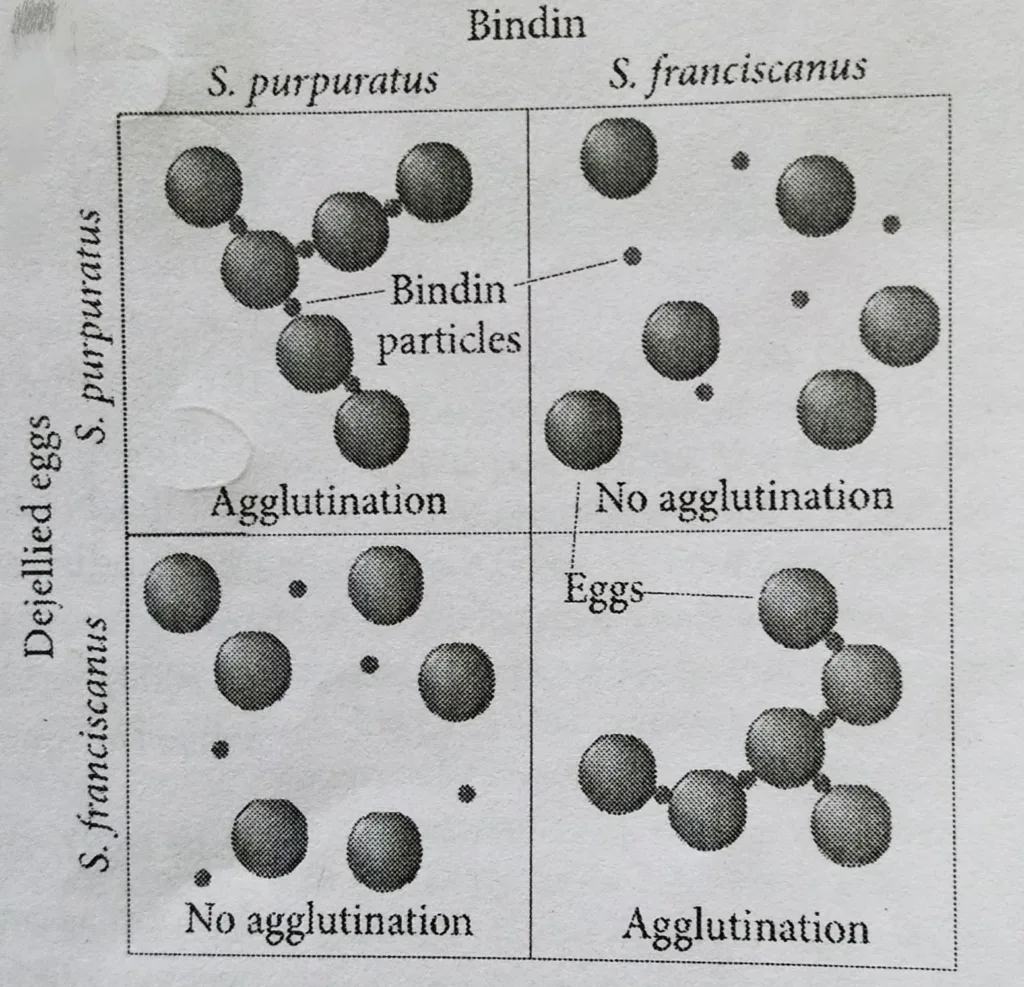
The agglutination of dejellied eggs by bindin was measured by adding bindin particles to a plastic well containing a suspension of eggs. After 2-5 minutes of gentle shaking, the wells were observed. The observation is elaborated in the above diagram.
Sea Urchin fertilization: Fusion of the egg and sperm cell membranes
- Sperm-egg fusion appears to be cause of polymerization of actin in the egg to form a fertilization cone.
- Fusion is an active process, mediated by a specific protein, named “fusogenic”. In sea urchins, bindin plays a second role as a fusogenic protein.
- In addition to recognizing the egg, bindin contains a long stretch of hydrophobic amino acids near its amino terminus, and this region can fuse phospholipid vesicles in vitro.
- Under the ionic conditions present in the mature unfertilized egg, bindin can cause the sperm and the egg membranes to fuse.
Other related notes:
- Patterns of cleavage: https://thebiologyislove.com/patterns-of-cleavage/
- Gamete fusion and prevention of polyspermy in mammals: https://thebiologyislove.com/gamete-fusion-the-prevention-of-polyspermy/
- Tetrapod limb development: https://thebiologyislove.com/tetrapod-limbs-development/
- Eye development in vertebrates: https://thebiologyislove.com/eye-development-in-vertebrates/
Facebook link: https://www.facebook.com/share/p/uN8BiYwDwsBEYn9P/?mibextid=oFDknk
Instagram link: https://www.instagram.com/p/C6YTH4HxIpV/?igsh=d3c3YTlwOGdzZjEy

